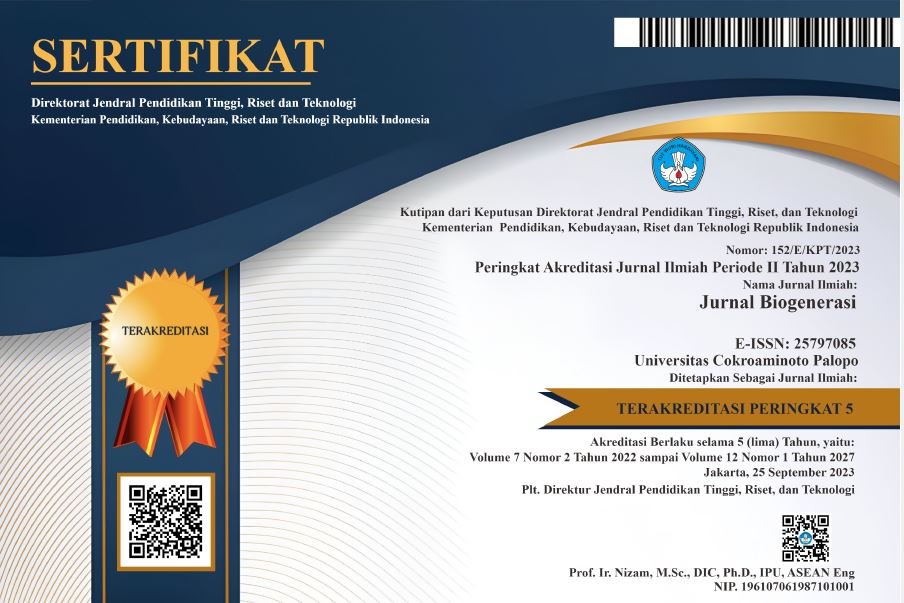IDENTIFIKASI TUMBUHAN EPIFIT PADA TANAMAN KELAPA SAWIT DI DESA KAKULLASAN KECAMATAN TOMMO KABUPATEN MAMUJU SULAWESI BARAT
DOI:
https://doi.org/10.30605/biogenerasi.v10i2.6254Keywords:
Identification, Epiphytic Plants, Oil Palm PlantsAbstract
This study aims to determine the types of epiphytic plants found in oil palm plantations in Kakullasan Village, Tommo District, Mamuju Regency, West Sulawesi. Sampling was conducted using the exploration method, namely exploring the predetermined location using 4 plots measuring 10x10 m, then taking samples found and recording the condition of the location or place where the epiphytic plants grow. From the results of the study, ferns (Pteridophyta) were found and no moss (Bryophyta) was found. The total number of ferns from each plot was 88 consisting of 9 types of species divided into 5 classes of ferns, namely Pteridopsida, Filicopsida, Polypodiopsida, Filicinae and Gleicheniopsida. For the Pteridopsida class, 3 types of species were found, namely Drynaria quercifolia, Phymatosorus scolopendria and Nephrolepis exalata. The Filicopsida class found the species Dryopteris filix-mas and the Polypodiopsida class found the species Vittaria lineata. Filicinae class found 3 types of species, namely Asplenium nidus, Davalia solida and Davalia denticulate. Gleicheniopsida class found 1 type of species, namely Gleichenia linearis. The dominance index ranges between 0.002 - 0.023 which means that no species dominates because none of them are close to the value of 1, while the species diversity index is classified as high because the diversity index value is H’ = 1.206 or greater than 1 (H>1)
Downloads
References
Aprilia, E. (2020). Pemupukan Pada Tanaman Kelapa Sawit (elaies guinessis jacq) di PT. Bumi Palma Lestari, Bagan Jaya Kecamatan Enok Kabupaten Indragiri Hilir Riau. Jurnal Agro Indragiri, 5(2), 48-51.
Gembong Tjitrosoepomo. (2014). Taksonomi Tumbuhan Schizophyta, Thallophyta, Bryophyta, Pteridophyta. Yogyakarta 55281:Kampus Univeritas Gadja Mada.Anggota IKAPI 1402012-C2E
Hartini, S. (2017 ). Tumbuhan Paku di Cagar Alam Sago Malintang, Sumatera Barat dan Aklimatisasinya di Kebun Raya Bogor. Biodiversitas, 7(3), 230- 236. ISSN: 1412033X.
Indriyanto, (2013), Ekologi Hutan, Jakarta, Bumi Aksara Dinas Kehutanan dan Perkebunan Kabupaten Nagan Raya, 2013.
Lestari, S. (2019). Identifikasi Tumbuhan Paku Sejati (Filicinae) Epifit di Gunung Pesagi Kabupaten Lampung Barat (Doctoral dissertation, UIN Raden Intan Lampung).
Odum, E.P., 1993. Dasar-Dasar Ekologi. UGM Press, Yogyakarta
Permana, N, E, P. (2017). Identifikasi Keanekaragaman Divisi Pteridophyta (Paku) di Kawasan Bukit Sulap Kota Lubuklinggau. Skripsi. Lubuklinggau: STKIP PGRI Lubuklinggau.
Purnomo, A. J., Anggraeni, A., & Astuti, R. K. (2017). Potensi Bakteri Penambat Nitrogen dan Penghasil Hormon IAA Dari Sampel Rhizosfer Paku Epifit di Mulut Gua Anjani, Kawasan Karst Menoreh, 1(2).
Romaidi, S. Maratus dan B. M. Eko. (2012). Jenis-jenis Paku Epifit dan Tumbuhan Inangnya di Tahura Ronggo Soeryo Cangar. El-Hayah 3 (1): 8- 15.
Sulastri, S., Wiharti, T., & Nugroho, A. A. (2019). Keanekaragaman Tumbuhan Paku di Kawasan Wisata Alam Candi Muncar Wonogiri Sebagai Bahan Penyusunan Modul Pembelajaran. Journal of Biology Learning, 1(1).ISSN : 2623-2243
Suraida, S., Susanti, T., & Amriyanto, R. (2013). Keanekaragaman Tumbuhan Paku di Hutan Kenali Kota Jambi. Prosiding Semirata FMIPA Universitas Lampung, 1(1): 387-392
Downloads
Published
How to Cite
Issue
Section
License
Copyright (c) 2025 Trisferni, suci wulan, Ahmad Hasyim

This work is licensed under a Creative Commons Attribution 4.0 International License.
In submitting the manuscript to the journal, the authors certify that:
- They are authorized by their co-authors to enter into these arrangements.
- The work described has not been formally published before, except in the form of an abstract or as part of a published lecture, review, thesis, or overlay journal.
- That it is not under consideration for publication elsewhere,
- That its publication has been approved by all the author(s) and by the responsible authorities – tacitly or explicitly – of the institutes where the work has been carried out.
- They secure the right to reproduce any material that has already been published or copyrighted elsewhere.
- They agree to the following license and copyright agreement.
License and Copyright Agreement
Authors who publish with this journal agree to the following terms:
- Authors retain copyright and grant the journal right of first publication with the work simultaneously licensed under Creative Commons Attribution License (CC BY 4.0) that allows others to share the work with an acknowledgment of the work's authorship and initial publication in this journal.
- Authors are able to enter into separate, additional contractual arrangements for the non-exclusive distribution of the journal's published version of the work (e.g., post it to an institutional repository or publish it in a book), with an acknowledgment of its initial publication in this journal.
- Authors are permitted and encouraged to post their work online (e.g., in institutional repositories or on their website) prior to and during the submission process, as it can lead to productive exchanges, as well as earlier and greater citation of published work.


.png)

